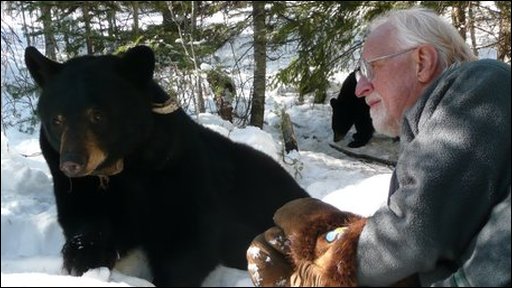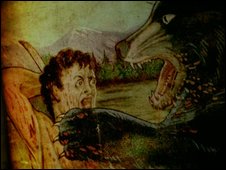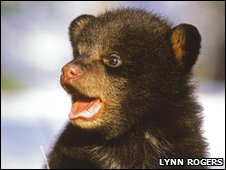
© Lynn RogersProfessor Lynn Rogers hangin out with black bears
Black bears are often considered among the most dangerous animals in North America, depicted down the years as ferocious predators threatening to man.
But, says one man, that perception could not be further from the truth.
For 43 years, has studied wild bears, walking and playing with them, gaining amazing insights into their behaviour.
His studies reveal the bears as peaceful, playful creatures, which even hum when they are content.
The new understanding of wild black bear (Ursus americanus) behaviour unveiled by Prof Roger's research is depicted by the BBC natural history programme Natural World:
Bearwalker of the Northwoods.
As part of the programme, the BBC film crew working with Prof Rogers recorded wild black bears mating for the first time.
When the male bear mounts the female, his body shakes in a behaviour that Prof Rogers calls "fluttering".
Contrary to popular opinion, mating bears aren't particularly dangerous.
In all his years observing the black bears, he has never been threatened by a black bear that is attempting to attract or mate with another.
In fact, he has never been attacked by any bear.
Black bear attacks on humans are incredibly rare, with most happening in the remote parts of Canada and Alaska, says Prof Rogers, who is director of the Wildlife Research Institute and the North American Bear Centre in Ely, Minnesota, US.

© UnknownA classic depiction of the black bear
"In the eastern US, there have been only three fatalities caused by black bears in the last hundred years," he says.
When Prof Rogers started his research in the 1960s, they had to tranquilise bears to get close to them.
But now he has worked out how to get the bears' trust.
One bear, which Prof Rogers has named June, is particularly amenable, allowing him to walk and rest with her in the forest.
"Everyone warns you never to go near a mother bear with cubs," says Prof Rogers.
Yet he is able to sit alongside June and her cubs as they exit their den and play. He is also able to do the same with another bear, named Juliet.
Before June hibernates for the winter, the bear allows Prof Rogers to monitor her heart rate on a daily basis.
Each day, prior to her entering her den, June's heart rate falls.
"It is not that she likes me, she trusts me," says Prof Rogers.
"For the first half of my life, I struggled to control my fear of bears. But bears like June have taught me that they are not the ferocious animals we once thought."
A knee jerk fear of bears often leads to people attempting to hunt them, says Prof Rogers, even out of season when it is illegal to do so.
"Walking with bears allows us to see the dangers they face," says Prof Rogers.
"Some people are so afraid of bears, they shoot them on sight, even when they pose no threat."
In the film, Prof Rogers and his field researcher Ms Sue Mansfield can be seen approaching a 400lb male bear that they believe had earlier been shot and wounded by a hunter.
Yet even this wounded bear is not aggressive towards them.
During the six week annual hunting season, Prof Rogers and his team tie pink ribbons around the bears they are researching, so that they are obvious to hunters, which hopefully will spare the animals.
Bears temporarily marked in this way are four times less likely to be shot by hunters.
There is also an assumption that feeding black bears may cause the animals to aggressively seek food out from walkers and campers.

© Lynn RogersBaby bear
"The funny thing is, there is no scientific evidence to support this," says Prof Rogers. "It is not what we see."
Other revelations gleaned by Prof Rogers during his research include the fact that black bears are susceptible to a parasite of deer.
Young bears can die after being infected by the pathogen, and Prof Rogers and his colleagues are now studying its impact on the black bear population.
Along with colleagues Dr Gustav Peters and Dr Megan Owen,
Prof Rogers has also studied in detail a particular behaviour of bears, known as "humming".
While humming, bears will exhale producing a series of between nine and 15 loud sounds a second.
When they reach the end of each breath, they quickly and silently inhale, before exhaling loudly again, continuing the humming sound.As yet, it is unclear why bears do this.
All bear species hum in this way, apart from giant pandas.
Natural World: Bearwalker of the Northwoods,
Wednesday 28 October, 2000GMT, BBC Two
Very good article folks...
Makes me think about 'playing' the bear today. Indeed among Qi Gong oldest practices (chinese say they play these technical movement concentration set) are the animals acting, and bear is a good one to play. I'll try it with the Hum.